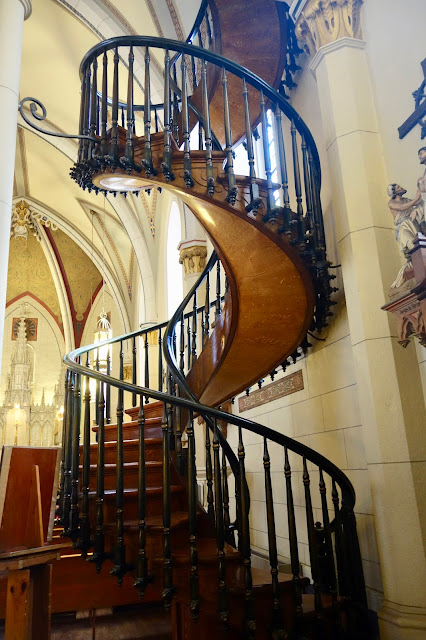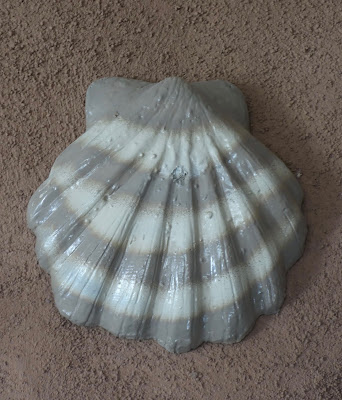a 2 part story from Santa Fe:
I believe in leaving room for the mysterious;
I believe in leaving room for the mysterious;
for accepting what can't be easily explained -
except through the prism of faith;
for recognizing that our knowledge of how the world works
is incomplete and inadequate
is incomplete and inadequate
at best.
Part One:
In Santa Fe,
there's a small chapel;
it's lovely but not anything to stop you in your tracks;
at least not until you hear about what's inside.
The Chapel of our Lady of Light
was established by the Sisters of Loretto in 1852.
was established by the Sisters of Loretto in 1852.
The sisters traveled from Kentucky,
by way of St Louis and Independence, MO,
through the western territories in a hazardous trek
which included being swept up in a cholera epidemic
that killed their Mother Superior
and left 2 other Sisters incapacitated.
They had been sent to establish a school and a convent
and, upon arrival in Santa Fe,
carpenters from Mexico began building those basic structures.
In 1873, a prosperous French benefactor designed a chapel for the sisters,
based on memories of his beloved Sainte Chapelle in Paris.
It was to be strictly Gothic -
the first Gothic structure west of the Mississippi -
and large.
It was to be 31 feet by 80 feet with an inside height of 73 feet.
Despite financial concerns,
work progressed under the patronage of St Joseph
to whom the sisters prayed every Wednesday.
It wasn't until it was nearly finished
that the sisters realized a dreadful mistake had been made.
The chapel and choir loft had no connecting link between the two.
There was no stairway and, because the loft was exceptionally high,
there was no room for a stairway as built back then.
The Mother Superior called in many carpenters -
who all failed miserably saying "It can't be done".
As the story goes,
The Sisters decided to pray a novena to St Joseph
and, on the last day, a gray haired man came to the convent
with a donkey and a tool box.
The only tools he had were a hammer, saw and a T-square.
He worked by himself throughout the Christmas season in 1879,
until he notified Mother Superior that it was done.
When she went to pay him, he had vanished.
She went to the local lumberyard to, at least, pay for the wood.
They knew nothing of it there.
The winding staircase makes two complete 360 degree turns.
There is no supporting pole up the center as most circular staircases have;
this means that it hangs with no visible means of support.
The entire weight is on the base.
Some architects who have examined it have said that,
by all laws of gravity,
it should have crashed to the floor the minute anyone stepped on it.
Yet it was used daily for nearly 90 years.
The staircase was put together only with wooden pegs;
there is not a single nail in it.
There are 33 steps in the staircase.
Many 'experts' have tried to identify the wood,
yet no one has ever been able to give a full report.
The treads have been consistently walked on since the staircase was built,
yet they only show signs of wear on the edges.
It has tentatively been identified as a previously unknown type of spruce
with the strength of hardwood
but the flexibility of spruce.
Where the carpenter got the wood is a mystery.
The identity of the carpenter has also never been explained.
For the faithful, no explanation is needed.
Part Two:
There's an even more humble structure about 1 hour outside of Santa Fe;
made of thick adobe walls
without a straight line or right angle to be found.
It's surrounded by taupe hills dotted with dark pinon trees
and the Acequia del Portero gurgles through its courtyard.
The hills in the native Tewa language are called Tsi Mayoh, which the Spanish,
in the late 16oo's, translated as "Chimayo".
For centuries,
its been believed to have been a place of miracles and answered prayers,
with dirt from its ground collected by the faithful.
Lore is that either a priest at prayer or a farmer plowing a field,
saw a beam of light emanating from the ground.
A cross was found buried in the dirt.
Three times,
the cross was moved to a church in another 'more prestigious' area
and, three times, the cross disappeared
only to be found at Chimayo again.
Understanding that the cross was meant to stay in Chimayo,
a chapel was built on the site in 1816.
Official church documents
show that miracles were already being attributed to the church
before its completion
and pilgrims were taking dirt
from the hole where the cross had been discovered,
believing it to be holy.
To many,
El Santuario de Chimayo is one of the most sacred places in the US,
similar to Lourdes in France.
An annual pilgrimage on Good Friday which started in the late 1940's,
today draws an estimated 35,000 participants.
References to the Camino,
a pilgrimage I know VERY well abound.
There is a power at Chimayo that is palpable
And whether that's the result of the place itself
or the accumulated faith of the thousands who have journeyed here
seems unimportant.
To say that altar is a stunning piece of 'folk art'
seems to do a disservice to both the altar
and the term 'folk art'.
El Chimayo was, without a doubt,
one of the highlights of my trip -
besides seeing Art Boy;
I'm so glad I got to share it with him.
If you want to exercise your faith
and not just your body while visiting Santa Fe,
these two places might just be the ticket!
And, just to be on the safe side,
I brought home a souvenir.
Some of us need all the extra spiritual mojo we can get!























No comments:
Post a Comment